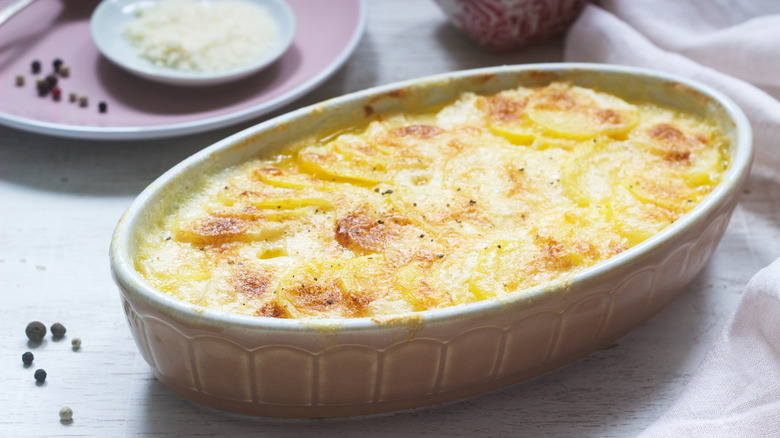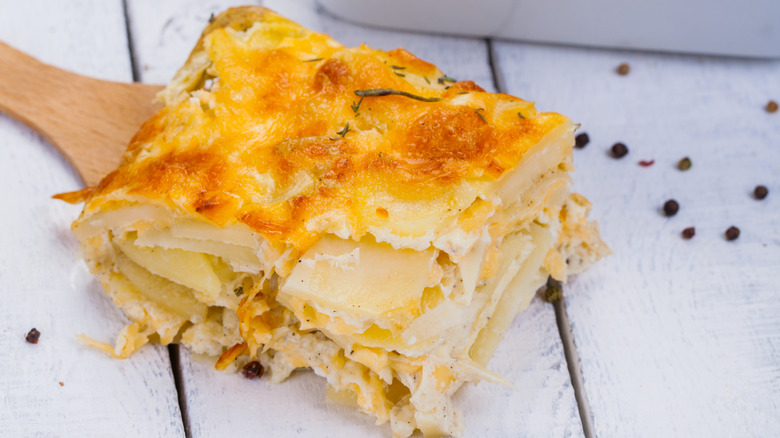What Exactly Are Dauphinoise Potatoes?
There are certain dishes that simply beg for a special occasion — rich, decadent, and tailored to gatherings of those we value the most. Dauphinoise potatoes certainly fit that description. Thin potato slices are mixed with a garlic-infused cream sauce, layered in a casserole dish, and then baked until the top is crisp and golden. Some versions add a topping of Gruyere cheese for an extra punch of flavor and texture. It's a menu staple at bistros throughout France and abroad, an ideal side dish to accompany steaks, beef tenderloin, roasted chicken, or just about any meat main you can think of. If you're entertaining guests, particularly during winter holidays, it's worth considering.
In their native France, dauphinoise potatoes are known as "gratin de pommes de terre dauphinoise" or simply "gratin dauphinoise". They should not be confused with the similarly-named dauphine potatoes, which are a type of fried croquette. There is a popular misconception that the dish was named for the Dauphin, the old title for the successor to the French throne and that it was specifically created for royalty. In reality, it was named for the historical region of Dauphiné, where it is traditionally made. The regal connection isn't entirely wrong, however, as the region was named for the fact that it was once the fiefdom of the Dauphin. Plus, the luxurious nature of this dish is truly worthy of a prince.
The difference between scalloped potatoes, potatoes gratin, and dauphinoise
You likely noticed that the description of dauphinoise potatoes bears a striking similarity to scalloped potatoes and potatoes au gratin. Their French appellation would seem to suggest that they're a type of gratin. But while all three dishes are closely related, being composed of thinly-sliced potatoes and a cream-based sauce, baked and served in a casserole dish, there are key differences that make each one distinct.
Scalloped potatoes are the simplest of the three, made with sliced potatoes baked in a sauce of milk, cream, and herbs. Scalloped potatoes typically use thicker slices than potatoes gratin or dauphinoise. Potatoes gratin is unique in two ways. Firstly, the potatoes are traditionally cooked ahead of time before being added to the sauce. Secondly, it includes cheese, usually Gruyere or Parmesan, tucked between each layer and generously sprinkled on top to form the crust. Dauphinoise potatoes fall somewhere between scalloped potatoes and gratin, as the spuds aren't precooked, though they do include cheese. However, traditional versions of dauphinoise are cheese-free, making them essentially the same as scalloped potatoes.
These days, it's much harder to distinguish between scalloped potatoes, gratin, and dauphinoise because modern recipes either confuse them for each other or intentionally create crossovers. Recipes for dauphinoise potatoes always seem to include cheese, while recipes for potatoes gratin sometimes skip the precooking stage. There's even a Julia Child recipe called "Gratin Dauphinois (Scalloped Potatoes au Gratin)," lumping all of them together.
The fundamentals of dauphinoise potatoes
Dauphinoise potatoes are one of those dishes that present as more complex to prepare than they really are. The French name certainly helps, adding a fancy flair to give it an edge over scalloped potatoes, even though the fundamentals are the same. There is, however, one crucial ingredient in dauphinoise that you typically don't find in either scalloped potatoes or potatoes gratin, and that's garlic. A couple of cloves can be added to the cream sauce as it simmers, imparting a key flavor. Many recipes also call for pinches of freshly-ground nutmeg.
Before you can get to the sauce, though, there is a crucial first step: selecting the right potatoes. Most modern recipes call for Yukon Gold potatoes, although this would not be a traditional choice, as they did not exist until 1966. What makes Yukon Gold potatoes so special in the eyes of many chefs is their starch content, which falls between that of waxy red-skinned potatoes and starchy russets. Because of this, Yukon Golds are able to soak up a lot of the dauphinoise cream sauce without losing their shape and turning mushy.
When making dauphinoise potatoes, you will have to decide whether or not to top it with cheese. This is really a choice between tradition and extra decadence. A classic dauphinoise incorporates no cheese, making the top layer of saucy potatoes nice and crispy. However, most contemporary recipes, even those from France, use grated Gruyere.


